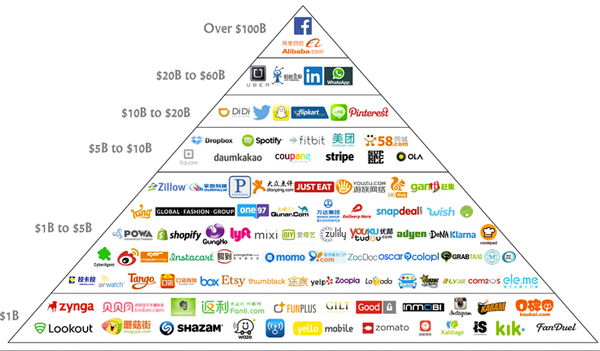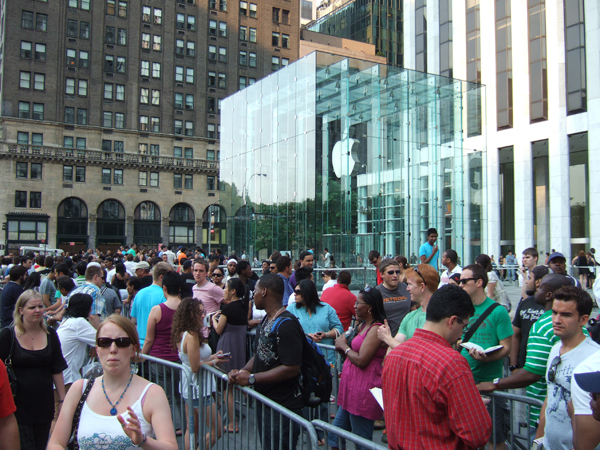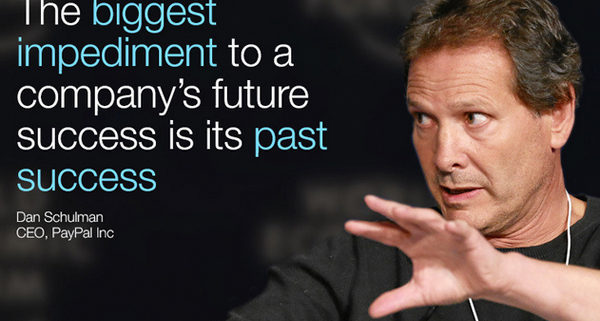The Power of Disruptor Brands and Challenger Brands
These days, it’s all about disruption. In tiny Davos, Switzerland, “The Fourth Industrial Revolution” was the central theme of the 2016 World Economic Forum, designed to engage thought leaders to prepare us for the “next big thing.”
The proposition is that we are on the cusp of a new era fundamentally changing the way we work and live. Vast technological changes brought on by digitalization are disrupting conventional business practices and social norms, states the economic forum founder, Professor Klaus Schwab, in his essay published by the Council on Foreign Affairs.[1]

Image via www.weforum.org
Enter Innovator Brands
A 2015 survey by Brand Keys on behalf of Business Performance Innovation (BPI) Network indicates that household brand names are being replaced by innovative game changers, and they’re gaining respect with mainstream consumers. “Nimble startups compete with legacy enterprises,” say 98 percent of those asked and “the disruption is severe,” indicate 37 percent. Furthermore, there is a “distinct correlation” between perceived innovation and a company’s bottom line results, according to the study.[2]

Image via www.bpinetwork.org
Challenger Versus Disruptor Brands
The terms challenger brand and disruptor brand are not interchangeable. Challenger brands bring innovation, enhancements, new pricing, or other tweaks (diet soda, dishwasher tablets, boy and girl nappies) to an existing marketplace.
Disruptors enter a marketplace and completely set heads spinning. When eBay appeared, for example, it was difficult for many people to accept paying online in advance for an item from a stranger and simply trusting it would arrive in the post. When email gained traction, traditional mail service was rattled and companies were required to re-define legalities in their terms and conditions. And when Airbnb was introduced, the hotel industry was more than mildly shocked; cities are still attempting to define tax issues.

Image via www.preweek.com
A Shift to the Customer Interface
The battle for today’s customer is occurring in the digital interface between product and consumer. As Tom Goodwin, senior vice president of strategy and innovation at Havas Media, explains, “Uber, the world’s largest taxi company, owns no vehicles. Facebook, the world’s most popular media owner, creates no content. Alibaba, the most valuable retailer, has no inventory. And Airbnb, the world’s largest accommodation provider, owns no real estate. Something interesting is happening.”[3]

Image via www.reddit.com
These companies fill a connector space between product and people. These brands are the jam in the sandwich between the customer and the business. Furthermore, Goodwin points out that this new breed of interface companies (Uber, YouTube, Airbnb, Snapchat, Twitter, WhatsApp, Facebook, Google) are the fastest-growing in history. All of them began as challenger brands.
What is a Challenger Brand?
From the original biblical tale, best-selling author Malcolm Gladwell borrows a title, “David and Goliath: Underdogs, Misfits, and the Art of Battling Giants,” reminding us that compelling storytelling has long been at the heart of a challenge. In brand marketing today, some famous challenges fall into the hero/underdog sort (Coke vs. Pepsi, Avis vs. Hertz; McDonalds vs. Burger King); others make into it a three-way contest, or even a Big Four fight (Tesco, ASDA, Sainsbury, Morrison’s).
Still other challenger brands enter a crowded category or endeavour to maintain challenger momentum once it starts to fade. Enter the game changers, disrupting the status quo by creating altogether new categories (Match.com, Uber, Airbnb), thus far a hallmark of 21st century disruptor brands.
In discussing the rise of the challenger brand, CMO of Adobe points out, “Essentially, the heart of a challenger brand is the passion, process, and tools they use to create and magnify customer advocacy.” Reflect on those overnight queues snaking around the Apple Store in anticipation of new product releases. “The heart of challenger brands’ success is their ability to turn emotion and affinity into a customer acquisition machine.”[4]
Purpose = Purchase = Profitability

Image via Rob DiCaterino, Flickr CC2.0
Challenger brand experts Adam Morgan and Mark Holden wrote a book on the subject, “Overthrow: Ten Ways to Tell a Challenger Story,” (with all profits going to UNICEF). In it, they list 10 types that represent the challenger brand state-of-mind. These brief descriptions may help you evaluate and identify your own brand’s personality, purpose and positioning.
The Irreverent Maverick
Shock and awe counts more than playing by the rules. This challenger type is big on attitude and best have a big budget for flashy PR, interactive sales tactics and legal advisors. Think Red Bull.
The Missionary
The core message is critical for this brand which identifies a need to do something better. The authors suggest. “Think of Al-Jazeera looking to ‘redress the balance’ in media coverage of the Middle East.
The Next Generation
Daring to call out the market leader as being old fashioned, this challenger seeks to position itself as very much here and now, totally relevant to today’s cultural trends. Emirates Airline, Euro Star and GoPro are examples.
The Democratiser
Sharing great design, catwalk looks and labels is the function of this challenger brand. Often seen in retailing, the purpose is to challenge elitist brands. The right influencers are often part of the equation to deliver street cred. Think H&M.
The Real and Human Challenger
Using people as a company resource, this brand breathes life into a dead category, fires up consumers’ imaginations. In the UK, Innocent (little tasty drinks), are those guys who drive around in those cow camouflage vehicles or Hungry Grassy Vans.
The Enlightened Zagger
Less fashionable is fine for brands that swim against the tide and challenge conventional wisdom. A brand challenge from Camper shoes mixed it up by suggesting that we walk, rather than run.
The Visionary
Big, bold and beautiful is the vision — but never boring. A visionary challenge brings a higher purpose and an emotional connection to the brand, Lady Gaga comes to mind.
The Game Changer
An entry into a category that’s unlike anything consumers have seen before is a game changer. The designers think outside the box. Steve Jobs brought game changers to categories from personal computing to phones, cameras and music.
The People’s Champion
This brand’s founder/CEO may act as the people’s champion, suggesting the public suffers an inferior service or product from everyone else in a category. The people’s champion puts a friendly face to the shakeup, using humour like Virgin boss Sir Richard Branson.
The Feisty Underdog
Here’s the David versus Goliath story in all its storytelling glory. It’s us versus them in the style of Avis Car Rental which adopted the slogan “We try harder. We’re #2,” a unique tagline that garnered empathy during its 50-year run.
Examples of Successful Challenger Brands
What do eggless mayonnaise, furniture in a box, bagless vacuum cleaners and fashionable spectacles have in common with driverless electric cars and return rockets for colonizing Mars? From aspirational to mainstream and from ideation to manufacture, challenger brands can change the world. Once a brand does achieve commercial success, a new set of opportunities comes into play in order to stay fresh edgy, and relevant, maintaining a challenger brand mentality as a bigger brand player.
1. Hampton Creek
Josh Tetrick, founder of this plant-based food maker, believes that industrialized egg and meat production is unsustainable. Hamptons Creek’s leading product, Just Mayo, is an egg-free spread that’s about making foods with less water, land, and carbon emissions. This is a brand that proves the business case for CSR and social responsibility.

Image via www.hamptoncreek.com
Since 2011, Tetrick has attracted funding from 12 billionaire investors, including Bill Gates, and shot to the top of several lists of innovative companies shaping the future of food.[5] The Guardian reports that Silicon Valley investors are pouring “serious cash into ersatz animal products. Their goal is to transform the food system the same way Apple changed how we use phones, or Google changed the way we find information.”[6]
2. IKEA
With 373 stores in 47 countries, no one would call Ikea a small company. Yet, it was born as a challenger concept in the back woods of Sweden in the 1940s: inexpensive flat-packed furniture for self-assembly, sold via a catalogue and warehouse showroom.[7] By remaining functional, simple, and design-led, Ikea has managed a harmonious marriage built on durable pillars of inexpensive, yet decent quality. Partnering with UNICEF among three dozen other NGOs and IGOs, IKEA Foundation[8] is considered the world’s largest charitable foundation, with an estimated net worth of $36 billion.

Image via www.ikeafoundation.org
3. Warby Parker
Four business school grads asked: Why is eyewear so costly? With US $2,500 in seed money from their university, they founded Warby Parker[9] in 2010, shaking up the supply chain dominated by one company. The challenger brand designs and manufactures fashionable spectacles in-house and provides eyewear via its innovative e-commerce site. The Home Try-On program comes with a free no-questions-asked return policy at a fraction of the price. For every pair of eyeglasses that’s sold, Warby Parker donates the funds to donate one pair to charity, currently over one million pairs of glasses.[10] CSR or Corporate Social Responsibility sits at the heart of this very compelling brand. The company is currently valued at US $1.2 billion.
4. Dyson
A few years ago, nobody (except James Dyson) imagined a vacuum cleaner without a vacuum cleaner bag that could operate by centrifugal force. Dyson worked for five years experimenting on 5,179 prototypes before taking a product to the marketplace. With research and design at its core, Dyson machines now include hand dryers, lighting and air treatments that are available in 65 countries. More than 1,000 engineers continually work on inventions.[11] The James Dyson Foundation sponsors design engineering students with scholarships and awards in the UK, USA and Japan.[12]

Image via www.jamesdysonfoundation.co.uk
5. Tesla Motors
Inventor, engineer and investor, self-made billionaire Elon Musk has a stable of disruptive products across multiple industries. From artificial intelligence to solar power to reusable rockets for space exploration, Tesla Motors electric cars are Musk’s best-known challenger brand. His entire stable of companies exist to contribute to Musk’s overarching vision: protecting Earth and humankind via sustainable energy sources and reducing the risk of human extinction by becoming a multi-planetary species. “Really pay attention to negative feedback,” is one of this entrepreneur’s top tips. Next up? “I really want to go to Mars,” says Musk, “It’s a fixer-upper of a planet.”[13]
A View from the Challenger Brand Grave
No stranger to failure, Steve Jobs said in his 2005 Stanford University commencement speech, “You have to trust in something — your gut, destiny, life, karma, whatever. This approach has never let me down, and it has made all the difference in my life.”[14]
And for challenger brands which do reach their goal, they must innovate, innovate, innovate. Success has a great way of dulling the keen edge of ambition; challenger brands can reach a comfort zone of complacency and constant change is the only answer.
Questions to consider
• Are you clear on the differences between a challenger brand and the need for a rebranding?
• Is your brand focused on a well-defined purpose?
• Have you figured out what you’re challenging and crafted a story that explains why?
• Do you have a fresh, imaginative, and stimulating idea, product or service, that you’re now ready to develop using brand profiling which provides your roadmap for bringing it life — making it distinctive, different and memorable so your primary audience can’t resist it?
• Do you have the ambitious challenger brand mentality? Are you a risk-taker at heart?
• Does your challenger brand represent a positive value for consumers?
• Do you have the conviction that your brand is something that will leave the world better off? Are you ready to leave an amazing legacy that changes peoples’ lives, and makes them better forever?
You may also like:
Brand Profiling: How Brand Performance and Purpose are Inextricably Linked
Rebranding Strategy: Why Your Rebrand Must Embrace Storytelling
The Profit Power of Cult Brands, Why and How to Create One
Brand Profiling: How to Use Emotion to Make Your Brand More Profitable
Brand Audits: 10 Things Successful Brand Owners and Managers Must Know
Brand Revitalisation and Relaunch: The do’s and don’ts of doing it successfully!
Brand CSR: The Business Case for Successful Branding and Social Good
Co-Branding: 13 Tips for Growing Your Brand Through Strategic Partnerships
[1] https://www.foreignaffairs.com/articles/2015-12-12/fourth-industrial-revolution
[2] http://www.bpinetwork.org/thought-leadership/views-commentary/395/new_digital_disruptors_that_gratify_and_excite_consumers_eclipse_tech_brand_incumbents_in_innovation_rankings
[3] http://techcrunch.com/2015/03/03/in-the-age-of-disintermediation-the-battle-is-all-for-the-customer-interface/#.wp0rsdo:0sCd
[4] http://www.cmo.com/articles/2013/12/3/rise_of_the_challeng.html
[5] https://www.facebook.com/hamptoncreek/info/?tab=page_info
[6] https://www.theguardian.com/science/2014/feb/14/silicon-valley-hack-food-industry
[7] http://www.ikea.com/ms/en_GB/about_ikea/our_business_idea/index.html
[8] http://www.ikeafoundation.org
[9] https://www.warbyparker.com/history
[10] https://www.warbyparker.com/buy-a-pair-give-a-pair
[11] http://www.dyson.com/community/aboutdyson.aspx
[12] http://www.jamesdysonfoundation.com
[13] https://www.youtube.com/watch?v=gV6hP9wpMW8
[14] http://news.stanford.edu/news/2005/june15/jobs-061505.html




Leave a Reply
Want to join the discussion?Feel free to contribute!